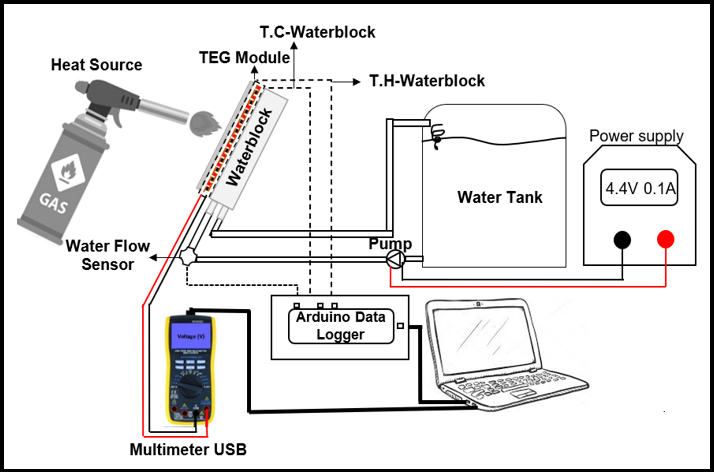Main Article Content
Abstract
Two third of the total energy in the internal combustion engine (ICE) system is lost and turns as waste heat through the exhaust system and coolant circulations. Therefore, it is necessary to have a technology that is able to convert waste heat from ICE into electrical energy using thermal electric generator (TEG). To have the best thermoelectric generator (TEG) performance in terms of higher electricity generation, the temperature on the hot surface should be higher, and the temperature on the cold surface should be as low as feasible. The goal of the study was to study how differences in TEG cooling systems affected the overall performance. Water block and heatsink-fan are two different types of cooling systems that have been used in this experiment. The water flow rate in water block cooling systems varies between 200, 300, 400, 500, and 600 l/h. The TEG module was heated with gas-fired lighters. Arduino-based data loggers were used to record hot and cold temperatures on the TEG surface. A USB multimeter is used to measure TEG performance as electrical voltage. The results showed that 300 l/h was the best water flow rate for TEG cooling. When using a water block cooling system instead of a heat sink, the electrical voltage generated by the TEG module is 12 percent higher. This study found that a cooling system with water blocks is superior to heatsink-fan.
Keywords
Article Details

This work is licensed under a Creative Commons Attribution-NonCommercial 4.0 International License.
References
- Thomas Kivevele, “LPG-Fueled Vehicles: An Overview of Technology and Market Trend,” Automotive Experiences, vol. 2, no. 2, pp. 41–46, 2019, doi: 10.31603/ae.v2i3.2766.
- J. H. Meng, X. D. Wang, and W. H. Chen, “Performance investigation and design optimization of a thermoelectric generator applied in automobile exhaust waste heat recovery,” Energy Conversion and Management, vol. 120, pp. 71–80, 2016, doi: 10.1016/j.enconman.2016.04.080.
- Q. Du, H. Diao, Z. Niu, G. Zhang, G. Shu, and K. Jiao, “Effect of cooling design on the characteristics and performance of thermoelectric generator used for internal combustion engine,” Energy Conversion and Management, vol. 101, pp. 9–18, 2015, doi: 10.1016/j.enconman.2015.05.036.
- Y. Wang, C. Dai, and S. Wang, “Theoretical analysis of a thermoelectric generator using exhaust gas of vehicles as heat source,” Applied Energy, vol. 112, pp. 1171–1180, 2013, doi: 10.1016/j.apenergy.2013.01.018.
- N. Karunakaran and V. Balasubramanian, “Effect of pulsed current on temperature distribution, weld bead profiles and characteristics of gas tungsten arc welded aluminum alloy joints,” Transactions of Nonferrous Metals Society of China (English Edition), vol. 21, no. 2, pp. 278–286, 2011, doi: 10.1016/S1003-6326(11)60710-3.
- Saniya LeBlanc, “Thermoelectric generators: Linking material properties and systems engineering for waste heat recovery applications,” Sustainable Materials and Technologies, vol. 1–2, pp. 1–37, 2014, doi: 10.1016/j.susmat.2014.11.002.
- H. B. Gao, G. H. Huang, H. J. Li, Z. G. Qu, and Y. J. Zhang, “Development of stove-powered thermoelectric generators: A review,” Applied Thermal Engineering, vol. 96, pp. 297–310, 2016, doi: 10.1016/j.applthermaleng.2015.11.032.
- P. M. Kumar et al., “The Design of a Thermoelectric Generator and Its Medical Applications,” Design, vol. 3, no. 2, pp. 1–26, 2019, doi: 10.3390/designs3020022.
- D. Champier, “Thermoelectric generators: A review of applications,” Energy Conversion and Management, vol. 140, pp. 167–181, 2017, doi: 10.1016/j.enconman.2017.02.070.
- C. C. Weng and M. J. Huang, “A simulation study of automotive waste heat recovery using a thermoelectric power generator,” International Journal of Thermal Sciences, vol. 71, pp. 302–309, 2013, doi: 10.1016/j.ijthermalsci.2013.04.008.
- G. J. Snyder, M. Soto, R. Alley, D. Koester, and B. Conner, “Hot Spot Cooling using Embedded Thermoelectric Coolers,” in Twenty-Second Annual IEEE Semiconductor Thermal Measurement And Management Symposium, 2006, pp. 135–143, doi: 10.1109/STHERM.2006.1625219.
- J. Siviter, A. Montecucco, and A. Knox, “Experimental Application of Thermoelectric Devices to the Rankine Cycle,” Energy Procedia, vol. 75, pp. 627–632, 2015, doi: 10.1016/j.egypro.2015.07.472.
- A. Elghool, F. Basrawi, T. K. Ibrahim, K. Habib, H. Ibrahim, and D. M. N. D. Idris, “A review on heat sink for thermo-electric power generation: Classifications and parameters affecting performance,” Energy Conv. and Manag., vol. 134, pp. 260–277, 2017, doi: 10.1016/j.enconman.2016.12.046.
- R. Y. Nuwayhid, D. M. Rowe, and G. Min, “Low cost stove-top thermoelectric generator for regions with unreliable electricity supply,” Renewable Energy, vol. 28, no. 2, pp. 205–222, 2003, doi: 10.1016/S0960-1481(02)00024-1.
- Y. S. H. Najjar and M. M. Kseibi, “Heat transfer and performance analysis of thermoelectric stoves,” Applied Thermal Engineering, vol. 102, no. March, pp. 1045–1058, 2016, doi: 10.1016/j.applthermaleng.2016.03.114.
- S. M. O. Shaughnessy, M. J. Deasy, J. V Doyle, and A. J. Robinson, “Performance analysis of a prototype small scale electricity-producing biomass cooking stove,” Applied Energy, vol. 156, pp. 566–576, 2015, doi: 10.1016/j.apenergy.2015.07.064.
- R. Mal, R. Prasad, and V. K. Vijay, “Multi-functionality clean biomass cookstove for off-grid areas,” Process Safety and Environmental Protection, vol. 104, pp. 85–94, 2016, doi: 10.1016/j.psep.2016.08.003.
- Y. H. Cho, J. Park, N. Chang, and J. Kim, “Comparison of cooling methods for a thermoelectric generator with forced convection,” Energies, vol. 13, no. 12, pp. 1–19, 2020, doi: 10.3390/en13123185.
- R. Kiflemariam and C. X. Lin, “Experimental investigation on heat driven self-cooling application based on thermoelectric system,” International Journal of Thermal Sciences, vol. 109, pp. 309–322, 2016, doi: 10.1016/j.ijthermalsci.2016.06.001.
- N. T. Atmoko, I. Veza, T. Widodo, and B. Riyadi, “Study On The Energy Conversion In The Thermoelectric Liquefied Petroleum Gas Cooking Stove With Different Cooling Methods,” International Journal of Engineering Trends and Technology, vol. 69, no. 1, pp. 185–193, 2021, doi: 10.14445/22315381/IJETT-V69I1P228.
- H. Lee, Appendix E: Thermoelectric Properties. John Wiley & Sons, Ltd., 2016.
- B. Pfeiffelmann and A. C. Benim, “Water-Cooled Thermoelectric Generators for Improved Net Output Power : A Review,” Energies, vol. 14, pp. 1–29, 2021, doi: 10.3390/en14248329.

